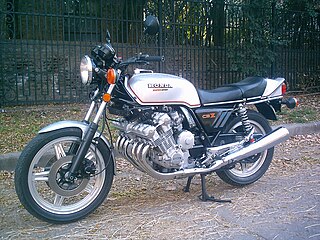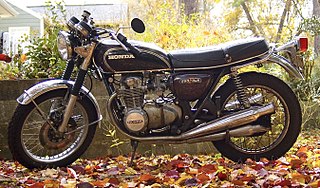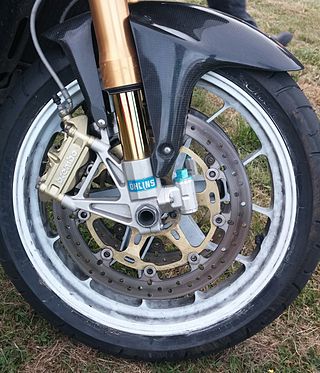The Honda XR series is a range of four-stroke off-road motorcycles that were designed in Japan but assembled all over the world.

The Honda CX series motorcycles, including the GL500 and GL650 Silver Wing variants, were developed and released by Honda in the late 1970s, with production ending in most markets by the mid 1980s. The design included innovative features and technologies that were uncommon or unused at the time such as liquid cooling, electric-only starting, low-maintenance shaft drive, modular wheels, and dual CV-type carburetors that were tuned for reduced emissions. The electronic ignition system was separate from the rest of the electrical system, but the motorcycle could only be started via the start button.
The CBX Prefix has been used by a number of motorcycles built by Honda.
The Honda CR series is a range of off-road motorcycles made by the Honda corporation from 1973 onwards.

The Honda CBX sports motorcycle was manufactured by Honda from 1978 to 1982. With a 1047cc inline six-cylinder engine producing 105 bhp (78 kW), it was the flagship of the Honda range. The CBX was well-received by the press, but was outsold by its sibling introduced in late 1979, the Honda CB900F.
The Yamaha Vision (XZ550) is a 550 cc 4 stroke 70° liquid cooled DOHC V-twin shaft-driven sport touring motorcycle produced in 1982-1983. With a range of innovative technology for its class, nimble handling, and bold styling, it was widely celebrated by the motorcycle press on its introduction as a bike ahead of its time.

The Honda CB500 Four is a standard 498 cc (30.4 cu in), air-cooled, 8-valve, SOHC, transverse inline-four motorcycle made by Honda from 1971 to 1978. It was introduced at the London Racing and Sporting Motorcycle Show in February 1972, and sold in the US market until 1973, replaced by the CB550 in the 1974 model year, while continuing in the European market until 1978. The CB500 Four is styled like the CB750, but smaller and lighter, with a claimed of 50 bhp (37 kW) output and a top speed of 115 mph (185 km/h).

The Honda CB550 is a 544 cc (33.2 cu in) standard motorcycle made by Honda from 1974 to 1978. It has a four-cylinder SOHC air-cooled wet sump engine. The first version, the CB550K, was a development of the earlier CB500, and like its predecessor, had four exhaust pipes, four silencers and wire-spoked wheels.

A motorcycle frame is a motorcycle's core structure. It supports the engine, provides a location for the steering and rear suspension, and supports the rider and any passenger or luggage. Also attached to the frame are the fuel tank and battery. At the front of the frame is found the steering head tube that holds the pivoting front fork, while at the rear there is a pivot point for the swingarm suspension motion. Some motorcycles include the engine as a load-bearing stressed member; while some other bikes do not use a single frame, but instead have a front and a rear subframe attached to the engine.

The VT250 or Spada MC20 is a Honda motorcycle built between late 1988 and the end of 1989.

The Yamaha RX 100 was a two-stroke motorcycle made by Yamaha from 1985 to 1996 with technical collaboration and distributed in India by the Escorts Group. At the initial stage, Yamaha Japan was exporting all bikes from Japan to India. After 1990, Escorts started production in India, with some parts being imported from Japan.

The first-generation Honda Civic is an automobile that was produced by Honda in Japan from July 1972 until 1979. It was their first genuine market success, eschewing the air-cooling and expensive engineering solutions of the slow-selling Honda 1300 and being larger than the minuscule N-series. The Civic laid down the direction Honda's automobile design has followed since.
The Honda CB900F is a Honda motorcycle made in two iterations which appeared some twenty years apart. Both generations of the CB900F are straight four-cylinder four-stroke 900 cc (55 cu in) roadsters.

The Honda CB250N and CB400N Super Dream are motorcycles manufactured by the Honda Motor Company from 1978 to 1986. The successor to the short lived Dream model, it had a series of revisions including a six-speed transmission and what Honda termed as European styling which resembled the CB750F and CB900F. It was a popular model for Honda with 70,000 bikes sold in the UK alone.

The Honda SS50 is a 50 cc (3.1 cu in) motorcycle manufactured by the Honda Motor Company.

The Honda NS125 was first presented at the Bologna Motor Show in December 1984 and went on sale in April 1985. The engine is a liquid cooled, 124.5 cc (7.60 cu in), two-stroke which used Honda's ATAC system. However the ATAC equipped models were not available in the UK. The NS was Honda's first attempt at the high end 125cc sports bike market in Italy; therefore it was built in Atessa, Italy and many of the parts used were made by well known Italian brands such as Dell'Orto for the carburetor, Marzocchi forks and single rear shock and Grimeca wheels and front disk brake. Honda, Japan supplied the spec sheets and a few parts like the electrics, piston and barrel.

The Honda SH50 is a 49 cc (3.0 cu in), air-cooled, two stroke, single cylinder, scooter style, restricted moped manufactured by the Honda Motor Company between 1984 and 2006, with substantial revisions for the 1996 model year. It was equipped with continuously variable automatic transmission, together with both electric and kick start, automatic choke and capacitor discharge electronic ignition. Brakes were drum front and rear, operated pedal-cycle style by two handlebar levers. The early models had some resemblance to Honda's C50/70/90 Super Cub range with a similar shape, dual seat and rear carrier, but with a scooter type floor, unlike the P series of mopeds such as the Honda PC50 or the Honda Express N series, which had cycle style construction. The SH50 was also known as the City Express and in some markets, as the Scoopy. All models had cycle type wheels as against the smaller wheels of later 50cc scooter style mopeds. The battery, fuel tank and two-stroke-oil reservoir were contained under the seat. Electrics were 12 volt and a handlebar mounted binnacle, which effectively formed part of the front bodywork, contained basic instrumentation and warning lights.

Motorcycle braking systems have varied throughout time, as motorcycles evolved from bicycles with an engine attached, to the 220 mph (350 km/h) prototype motorcycles seen racing in MotoGP. Most systems work by converting kinetic energy into thermal energy (heat) by friction. On motorcycles, approximately 70% of the braking effort is performed by the front brake. This however can vary for individual motorcycles; longer-wheelbase types having more weight biased rearward, such as cruisers and tourers, can have a`greater effort applied by the rear brake. In contrast, sports bikes with a shorter wheelbase and more vertical fork geometry can tolerate higher front braking loads. For these reasons, motorcycles tend to have a vastly more powerful front brake compared to the rear.

The Honda CB125TD Super Dream is a 124 cc (7.6 cu in) air-cooled, four stroke, twin cylinder motorcycle manufactured by the Honda Motor Company between 1982 and 1988, in three designations, TDC, TDE and TDJ. Intended as a sportier version of the Honda CD125 and CM125 it was similarly restricted to a maximum of 12 hp (8.9 kW), in compliance with the provisional licence requirements of the time, so that it could be used by novice riders.

The CB 750 K(Z) is a motorcycle model by the Japanese vehicle manufacturer Honda.















